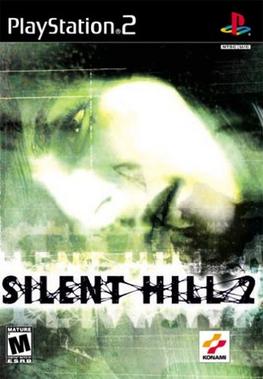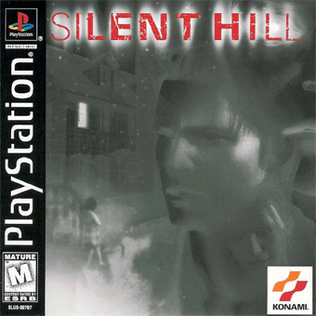Silent Hill is a horror anthology media franchise centered on a series of survival horror games created by Keiichiro Toyama and published by Konami. The first four video games in the series, Silent Hill, Silent Hill 2, Silent Hill 3, and Silent Hill 4: The Room, were developed by an internal group called Team Silent, a development staff within former Konami subsidiary Konami Computer Entertainment Tokyo.
Adrian Lyne is an English film director. In the mid 1970s, he directed television commercials for DIM Lingerie (France).

House on Haunted Hill is a 1999 American supernatural horror film directed by William Malone and starring Geoffrey Rush, Famke Janssen, Taye Diggs, Ali Larter, Bridgette Wilson, Peter Gallagher, and Chris Kattan. The plot follows a group of strangers who are invited to a party at an abandoned insane asylum, where they are offered $1 million each by an amusement park mogul if they are able to survive the night. Produced by Robert Zemeckis and Joel Silver, it is a remake of the 1959 film of the same title directed by William Castle, and features special effects by famed make-up artists Gregory Nicotero and Dick Smith.

Silent Hill 2 is a 2001 survival horror game developed by Team Silent, a group in Konami Computer Entertainment Tokyo, and published by Konami. The game was released from September to November, originally for the PlayStation 2. The second installment in the Silent Hill series, Silent Hill 2 centers on James Sunderland, a widower who journeys to the town of Silent Hill after receiving a letter from his dead wife. An extended version containing an extra bonus scenario, Born from a Wish, and other additions was published for Xbox in December of the same year. In 2002, it was ported to Microsoft Windows and re-released for the PlayStation 2 as a Greatest Hits version, which includes all bonus content from the Xbox port. A remastered high-definition version was released for the PlayStation 3 and Xbox 360 in 2012 as part of the Silent Hill HD Collection.

The Black Cat is a 1934 American pre-Code horror film directed by Edgar G. Ulmer and starring Boris Karloff and Béla Lugosi. It was Universal Pictures' biggest box office hit of the year, and was the first of eight films to feature both Karloff and Lugosi. In 1941, Lugosi appeared in a comedy horror mystery film with the same title, which was also named after and ostensibly "suggested by" Edgar Allan Poe's short story.

Deadly Friend is a 1986 American science fiction horror film directed by Wes Craven, and starring Matthew Laborteaux, Kristy Swanson, Michael Sharrett, Anne Twomey, Richard Marcus, and Anne Ramsey. Its plot follows a teenage computer prodigy who implants a robot's processor into the brain of his teenage neighbor after she is pronounced brain dead; the experiment proves successful, but she swiftly begins a killing spree in their neighborhood. It is based on the 1985 novel Friend by Diana Henstell, which was adapted for the screen by Bruce Joel Rubin.

"An Occurrence at Owl Creek Bridge" (1890) is a short story by American writer and Civil War veteran Ambrose Bierce, described as "one of the most famous and frequently anthologized stories in American literature". It was originally published by The San Francisco Examiner on July 13, 1890, and was first collected in Bierce's book Tales of Soldiers and Civilians (1891). The story is set during the American Civil War and is known for its irregular time sequence and twist ending. Bierce's abandonment of strict linear narration in favor of the internal mind of the protagonist is an early example of the stream of consciousness narrative mode.

Silent Hill is a 2006 supernatural horror film directed by Christophe Gans and written by Roger Avary, based on the video game series of the same name published by Konami. The first installment in the Silent Hill film series, it stars Radha Mitchell, Sean Bean, Laurie Holden, Deborah Kara Unger, Kim Coates, Tanya Allen, Alice Krige and Jodelle Ferland. The plot follows Rose da Silva, who takes her adopted daughter, Sharon, to the town of Silent Hill, for which Sharon cries while sleepwalking. Rose is involved in a car accident near the town and awakens to find Sharon missing. While searching for her daughter, she fights a local cult and begins to uncover Sharon's connection to the town's dark past.
Pruitt Taylor Vince is an American character actor. He had roles in the films Mississippi Burning (1988), Jacob's Ladder (1990), JFK (1991), Identity (2003), and Constantine (2005). He played J.J. Laroche in The Mentalist (2008–2015).
Bruce Joel Rubin is an American screenwriter, meditation teacher, and photographer. His films often explore themes of life and death with metaphysical and science fiction elements. Prominent among them are Jacob's Ladder, My Life and Ghost, for which he received the Oscar for Best Original Screenplay. Ghost was also nominated for Best Picture, and was the highest-grossing film of 1990. He is sometimes credited as "Derek Saunders" or simply "Bruce Rubin".
Psychological thriller is a genre combining the thriller and psychological fiction genres. It is commonly used to describe literature or films that deal with psychological narratives in a thriller or thrilling setting.

Pyramid Head, also known as "Red Pyramid", "Red Pyramid Thing", or "Triangle Head" is a character from the Silent Hill series, a survival horror video game series created by Japanese company Konami.

Silent Hill is a 1999 survival horror game developed by Team Silent, a group in Konami Computer Entertainment Tokyo and published by Konami. The first installment in the video game series Silent Hill, the game was released exclusively for the PlayStation. Silent Hill uses a third-person view, with real-time rendering of 3D environments. To mitigate limitations of the console hardware, developers used fog and darkness to muddle the graphics and the pop-ins, which in return helped set up the atmosphere and mystery of the game. Unlike earlier survival horror games that focused on protagonists with combat training, the player character of Silent Hill is an "everyman".

Silent Hill 3 is a 2003 survival horror game developed by Team Silent, a group in Konami Computer Entertainment Tokyo, and published by Konami. The game was released from May to August, originally for the PlayStation 2. The third installment in the Silent Hill series and a direct sequel to the first Silent Hill game, it follows Heather, a teenager who becomes entangled in the machinations of the town's cult, which seeks to revive a malevolent deity. A port for Microsoft Windows was released later in November, and a remastered high-definition version was released as part of the Silent Hill HD Collection, for the PlayStation 3 and Xbox 360 in 2012.

Silent Hill 4: The Room is a 2004 survival horror game developed by Team Silent, a group in Konami Computer Entertainment Tokyo, and published by Konami. The fourth installment in the Silent Hill series, the game was released in Japan in June and in North America and Europe in September. Silent Hill 4 was released for the PlayStation 2, Xbox, and Microsoft Windows. Its soundtrack was released at the same time. In 2012, it was released on the Japanese PlayStation Network. On October 2, 2020, it was re-released on GOG.com with patches to make it playable on Windows 10.

The Cat and the Canary is a 1927 American silent comedy horror film directed by the German Expressionist filmmaker Paul Leni. An adaptation of John Willard's 1922 black-comedy play of the same name, the film stars Laura La Plante as Annabelle West, Forrest Stanley as Charlie Wilder, and Creighton Hale as Paul Jones. The plot revolves around the death of Cyrus West, who is Annabelle, Charlie, and Paul's uncle, and the reading of his will twenty years later. Annabelle inherits her uncle's fortune, but when she and her family spend the night in his haunted mansion, they are stalked by a mysterious figure. Meanwhile, a lunatic mainly known as the Cat escapes from an asylum and hides in the mansion.

Silent Hill: Shattered Memories is a 2009 survival horror game developed by Climax Studios and published by Konami Digital Entertainment. It was released in December for the Wii and ported to the PlayStation 2 and PlayStation Portable platforms in January 2010. In April 2014, it appeared on the PlayStation Network in Europe.

Thriller film, also known as suspense film or suspense thriller, is a broad film genre that evokes excitement and suspense in the audience. The suspense element found in most films' plots is particularly exploited by the filmmaker in this genre. Tension is created by delaying what the audience sees as inevitable, and is built through situations that are menacing or where escape seems impossible.

Silent Hill: Revelation is a 2012 supernatural horror film written and directed by M. J. Bassett and based on the video game series Silent Hill published by Konami. It is the second installment in the Silent Hill film series. The film, produced as a sequel to Silent Hill (2006), stars Adelaide Clemens, Kit Harington, Martin Donovan, Malcolm McDowell and Carrie-Anne Moss, with Deborah Kara Unger, Sean Bean and Radha Mitchell returning from the previous film. The plot follows Heather Mason (Clemens), who, discovering on the eve of her eighteenth birthday that her presumed identity is false, is drawn to the town of Silent Hill.
Art horror or arthouse horror is a sub-genre of both horror films and art-films. It explores and experiments with the artistic uses of horror.














